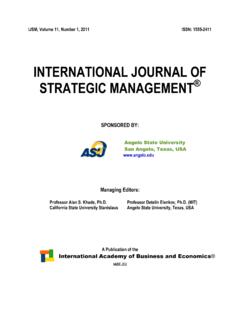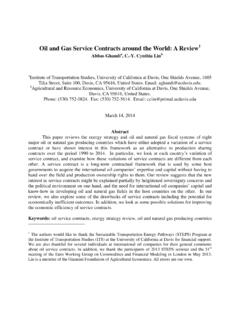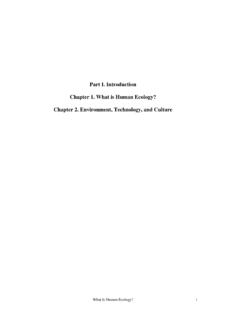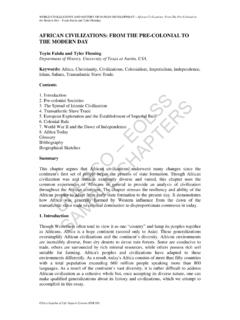Transcription of Chapter 25. ORIGIN OF FOOD PRODUCTION
1 ORIGIN of food Production25-469 Chapter 25. ORIGIN OF food PRODUCTION While observing the barbarous inhabitants of Tierradel Fuego, it struck me that the possession of some property,a fixed abode, and the union of many families under a chief,were the indispensable requisites for civilization. Such hab-its almost necessitate the cultivation of the ground; and thefirst steps would probably from some such accidentas the seeds of a fruit tree falling on a heap of refuse, and pro-ducing some unusually fine variety. The problem, however,of the first advance of savages toward civilization is atpresent much too difficult to be solved. C. Darwin,DescentofMan(1874)I. IntroductionThis change in subsistence patterns from hunting and gathering to agriculture wasthe first unambiguously CULTURAL revolution in human technology and an interesting and important macro-evolutionary phenomenon.
2 All previouschanges, as we saw in the last Chapter , entailed genetic changes insofar as modifications inmorphology were involved. Humans seem to have become biologically modern in South-ern Africa by perhaps 100,000 years ago, and fully modern people had replaced Neander-thals by ca 40,000 bp in the remote outpost of glacial Europe. The agricultural revolution,by contrast, was primarily technological, behavioral and social. Any associated geneticchanges are likely to have been an insignificant part of the food PRODUCTION changes in the culture core occasioned by the development of a subsistencebased on plant and animal domestication was in some ways as dramatic as any of the bio-cultural transformations of the deeper past (see Chapters 4 and 6). A full-blown agrariansociety of millions of people is in some ways a big or bigger step in terms of social organi-zation as the step from a weakly cooperative primate troop of 60 animals to the cooperativehunting band of the same size1.
3 The food PRODUCTION revolution greatly impressed earlierscholars because it was the economic basis of civilization literacy, mathematics, statepolitical organization, and the like. There is no doubt that this complex of traits derivingindirectly from agriculture represent impressive changes from hunting and gathering. In in-dustrial societies today we are still dealing with the ramifications of the food productionrevolution that began 10,000 years Although recall that the hunting band is really part of a larger society of some hundreds to thou-sands of individuals of the same linguistic/cultural group, a unit with no real parallel in the of food Production25-470 The evolution of food PRODUCTION has been intensively studied since the early 1950sand thus the development of societies dependent on food PRODUCTION is also much betterknown than any earlier transformation of human ecological patterns.
4 The sites for studyingthis development are numerous because they are relatively recent and the food foragerswho gave rise to them were populous. Several major archeological teams, beginning in the1950s, conducted a number of quite sophisticated studies designed explicitly to test earlierhypotheses about agricultural origins. Archeologists of an earlier generation working in theregions of the first civilizations V. Gordon Childe is the best known name had made in-teresting speculations about this most important early projects were led by Robert and Linda Braidwood (in theNear East) and Richard MacNeish (in Mesoamerica and the Andes). These investigators ledmultidisciplinary teams of archeologists, botanists, zoologists, radiocarbon daters, ecolo-gists, and geomorphologists to study in areas carefully selected to be in the likeliest areasfor the transformation from hunting and gathering to agricultural subsistence.
5 They delib-erately looked for evidence of plant and animal domesticates and other aspects of the eco-logical relations of the succession of societies across the transition. The result of these andsimilar investigations gives a fairly clear picture of the events of the revolution, althoughthe processes involved are less clear. A large literature interpreting the events in terms ofprocesses has grown up in the period since these investigations began. Prominent namesassociated with process hypotheses to explain agricultural origins include Kent Flanneryand Lewis Binford. A number of botanists were also attracted to work on the evolution ofplant domesticates from their wild ancestors. The work of Paul Manglesdorf and GeorgeBeadle on maize is especially noteworthy. The climate record over the relevant interval isrecent enough to be comparatively easy to study, and is consequently fairly well The EvidenceA.
6 The Agricultural or Neolithic RevolutionThere are three non-controversial centers of crop domestication for which the ar-cheological data are good and which are known to represent independent are listed below:1. Near East beginning about 9,500 Meso-America beginning about 7,200 Peruvian highlands beginning about 6,500 of food Production25-471 Evidence for the cultivation of rice in the Far East (Thailand), beginning about 8,500 BPis more controversial, as is the evidence for tropical root crop agriculture in West 25-1 shows the centers of plant and animal domestication. The main crop plants tobe first domesticated were large-seeded grasses and other annuals, maize, wheat, rice,beans, and many others. Highland Peru and the lowland tropics differed in the kinds ofplants used--there the emphasis was on root crops (MacNeish, 1977).
7 A little after 10,000 years bp, agriculture broke out all over the world, like mea-sles. The several centers of domestication are almost contemporaneous and developmentsare very rapid (relative to a geological time scale or the time scale of human evolution atany earlier time). Indeed, although the agricultural revolution took an average of about4,000 years to go from food foraging to complete dependence on domesticated products,on an evolutionary time scale this was a sudden, rapid a punctuational eventif ever there was such, though it was still well within the scope of ordinary microevolution-ary processes to of food Production25-472 Figure 26-1. Centers of plant and animal domestication. Copied fromThe Times Concise Atlas of World History(1982:7). ORIGIN of food Production25-473 There were similar stages in each regional case.
8 Table 25-1 illustrates with the Meso-Amer-ican 25-1. Outline of the basic archeological data recovered by Richard Mac-Neish in the Techuacan Valley, Southern Mexican Highlands. This is one ofthe classical examples of ORIGIN -of-agriculture excavation studies (adaptedfrom MacNeish, 1964).PhaseDates bpEstimatedPopulation(in 2,400km2valley)Culture Core%Animalsin Diet%Deomesti-cated Plantsin DietAjuereado>9,20010-20 Big game hunting, including nowextinct horses, antelopes andmammoths, but small game special tools to pro-cess plant bands,highly mobile.>50(?)0El Riego9,200-7,20050-70 Broader spectrum of plant foodsusedincluding protocultivarsofsquash, chili, & tools. Macrobandcampsin wet season. Shamans, ceremo-nial ,200-5,400150-180 Still more specialized plant collec-tors witha bit of plant gourds, beans, used wildcorn.
9 Larger wet season camps,butstill microbands in dry &Purron5,400-3,500350-700 More sedentary, less use ofmicroband domesti-cated corn. Potterydeveloped &Santa Maria3,500-2,2001,000-4,000 Almost completely sedentary, withmud houses. Mainly domesticatedplants. Fancy pottery, ceremonialcenters (temples). Possible start Blanco2,200-1,30018,000-26,000 Full-time agriculture,irrigationheavily domesticatesinclude tomatoes & turkeys. Largeceremonial centers, pyramids, & ,300-45080,000-90,000 Commerce becomes townsas well asceremonial SpanishConquest~450 Domesticated animals and metal-lurgy of food Production25-474 Pleistocene big game hunters give way to specialized food foragers a few thousandyears as a consequence of the broad spectrum revolution . The classic big game huntingpeople of the Pleistocene showed little signs of using much plant matter, or even small an-imals and fish.
10 However, over time these specialized food foragers built up larger popula-tions per unit of land area and were forced to begin exploiting lower quality resources. Theydeveloped seed grinding equipment, digging tools, etc., preadapted to plant event is known by the archeologists term the broad spectrum revolution . In ad-dition to greater use of plants, it includes a tendency toward settled villages in favored ar-eas, use of fish, shellfish, and small animals in much greater numbers than in thePleistocene. For example, in the Highland Andes, deer bones declined sharply in middens2,and guinea pig bones became very common, as a part of the broad spectrum revolution. An-other good example is the shift in California from Folsom type peoples with a toolkit adapt-ed for hunting big game to the acorn grinding, salmon drying people of the contact of these societies began to use the wild progenitors of what eventually became cropplants.















